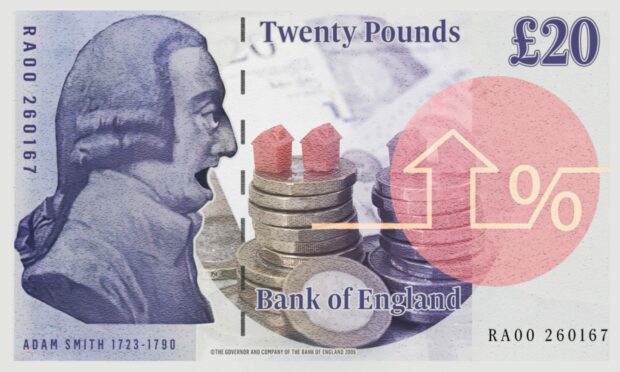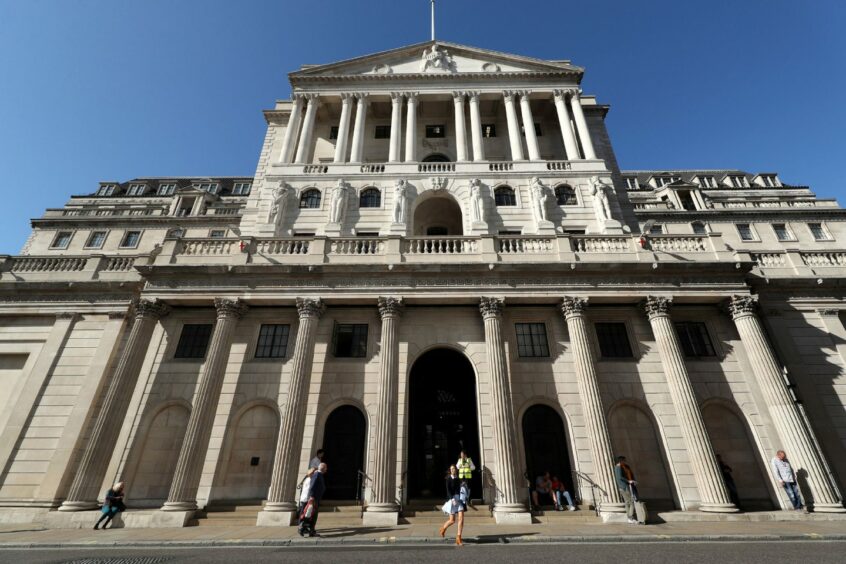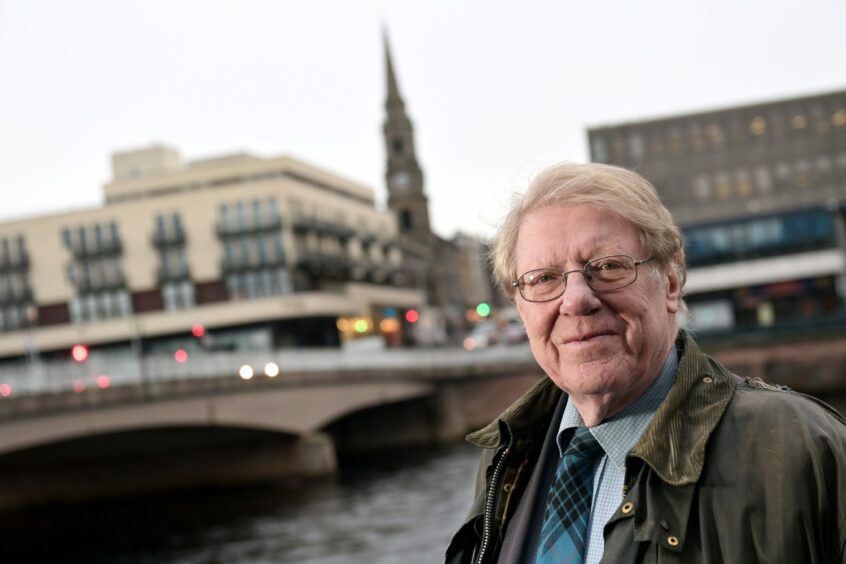Households face higher borrowing and mortgage costs after the Bank of England raised interest rates in the biggest leap for 27 years.
The UK’s central bank further warned the economy will be plunged into recession, dragged down by huge rises in energy and petrol costs, adding further to the cost of living crisis.
The rate hike – which pushed the bank’s base rate up 0.5% to 1.75% – ratchets up pressure on households who could be forking out hundreds of pounds more from October, experts have warned.
The cost rises prompted one charity to warn that some families in Scotland will have to choose between freezing or starving this winter, as inflation is projected to hit more than 13%.
Kevin Brown, savings specialist at Scottish Friendly, said: “Today’s base rate rise will squeeze household incomes even tighter by pushing borrowing costs to their highest level since 2009, and the worst is still to come.”
Why is the interest rate rising?
Inverness-based economist Tony Mackay said the bank needs to act as countries around the globe are raising interest rates in efforts to put the brakes on spiralling inflation.
He said: “The bank has been strongly criticised in recent months for not increasing the base rate as much as other banks such as the European Central Bank and the Federal Reserve Bank in the USA.
“The expectation is that a rise in the base rate will bring down inflation by reducing consumer spending.”
However, he said he doubts the rise will help because costs are going up due to external factors such as the war in Ukraine and shortages caused by Covid and Brexit.
“The main reason for the recent huge rise in inflation has been the impact of the Ukraine-Russia war on energy prices, not increased consumer spending in the UK,” he said.
Will my mortgage cost go up?
Mr Mackay highlighted all other interest rates – on borrowing such as credit cards or bank debt including mortgages are linked to the base rate – albeit they are much higher.
He said: “For most borrowers, the most important is the mortgage rate. A 0.5% increase in the base rate is likely to increase most mortgage rates by 2.0 to 2.5%.
“That will inevitably reduce the demand for houses because potential buyers will have less money available.
“It should also have a similar impact on house prices.
“However, it is difficult to predict the scale of the latter because there are currently big shortfalls in the supply of housing in many parts of the P&J area.
“There has been a huge fall in new building in the last two years because of the impact of the coronavirus pandemics.
“I therefore expect the Bank of England increase to have noticeable impacts on the local housing markets but not on the overall inflation rate.”
House prices at ‘tipping point’
In Aberdeen, Raeburn Christie Clark & Wallace partner Gavin Cooper said homeowners and landlords are facing higher repayments, while higher costs could see more properties come on to the market, driving down prices.
“Rising interest rates can increase the monthly mortgage payments required to be met by homeowners and landlords if they aren’t currently on a fixed rate deal with their lender,” he said.
“The higher that interest rates rise, the higher the mortgage payments become.
“The added pressure of general inflation during the current cost of living crisis means that some may start to find it more difficult to meet their monthly outgoings.
“Whilst no immediate effect on house prices is to be expected, there could become a tipping point as rises start to have an effect.
“In the longer term, if landlords are unable to charge enough by way of rent to cover any mortgage payments due there becomes an incentive to sell.
“Additionally, it may reach the point that homeowners are forced to sell because they can no longer meet monthly mortgage payments.
If landlords are unable to charge enough by way of rent to cover any mortgage payments due there becomes an incentive to sell.
Additionally, it may reach the point that homeowners are forced to sell because they can no longer meet monthly mortgage payments.”
Raeburn Christie Clark & Wallace partner Gavin Cooper
“We would then expect to see a greater supply of properties coming onto the market. When supply outstrips demand, house prices would likely fall but we’re not there yet.
“There is currently a healthy demand for properties in Aberdeen and the north-east and it remains to be seen whether there will be a prolonged and successive rise in interest rates sufficient to affect the market.”
Housing market still resilient
Aberdein Considine’s national estate agency director Alan Cumming said the base rate of interest was still low by historic standards – the rate hit 5.75% in July 2007 but has declined since then to severe lows after the 2008 banking crisis.
He expects house prices to remain resilient, particularly in the north-east where the market has been enjoying a recovery.
“Like the rest of Scotland, and indeed the UK, the north-east property market has been performing well since a restart after the first lockdown of 2020,” he said.
“Over the last two years the buoyant conditions have driven an increase in average price and also volume of sales.
“And over the course of this year, the Aberdeen city flat market has turned a corner with demand on the up which is starting to erode the high volume of flats available for sale.
“Despite a fairly substantial increase in the BoE base rate, it is still relatively low compared to levels seen in 2007.
“Unemployment remains at a historic low and the availability of jobs is strong, giving buyers and sellers confidence to make a move.
Despite a fairly substantial increase in the BoE base rate, it is still relatively low compared to levels seen in 2007.”
Aberdein Considine national estate agency director Alan Cumming
“It is also worth remembering that approximately 20% of home buyers use cash to purchase their property and are therefore not directly affected by an increase in mortgage interest rates.
“Typically, however, a rise in rates can slow the upper end of the market and the Scottish Government need to think carefully about the punitive tax burdens applied when purchasing a property in Scotland.
“The recent change to mortgage affordability testing will make it easier for first time buyers to get onto the property ladder which should help stimulate the market at the lower end.”
Worse to come?
Derek Mitchell – the chief executive of Citizens Advice Scotland – called for “radical action” from government.
“Soaring inflation means higher prices in the shops and costs on bills for people already struggling badly with the cost-of-living crisis,” he said.
“That inflation is expected to stay high for much of 2023 and the looming prospect of a recession means this crisis isn’t going anywhere, risking a legacy of debt, poverty and destitution for years and years to come.
“Some of the most vulnerable people across the UK this winter will face a choice between freezing and starving.”
Key facts:
- Homeowners whose mortgages directly track the Bank of England base rate will see around £50 per month added to their costs typically, according to industry calculations.
- The Bank of England raised the base rate by 0.50 percentage points on Thursday, taking it from 1.25% to 1.75%, marking the biggest single rate jump since 1995.
- The UK is set to fall into its longest recession since the financial crisis and inflation will peak at more than 13% as gas prices soar, the Bank of England has warned.
- Consumer Prices Index inflation will hit 13.3% in October, the highest for more than 42 years, if regulator Ofgem hikes the price cap on energy bills to around £3,450, the bank’s forecasters said.





Conversation